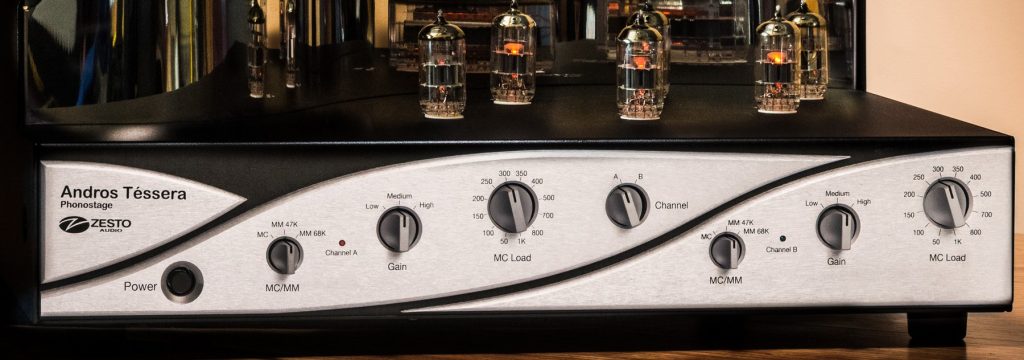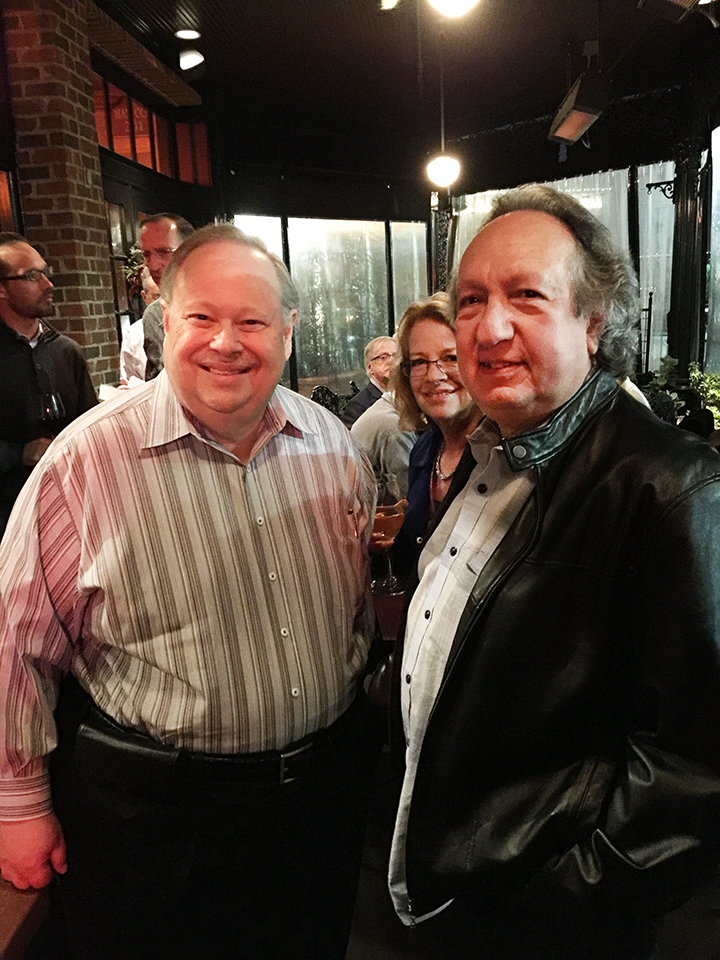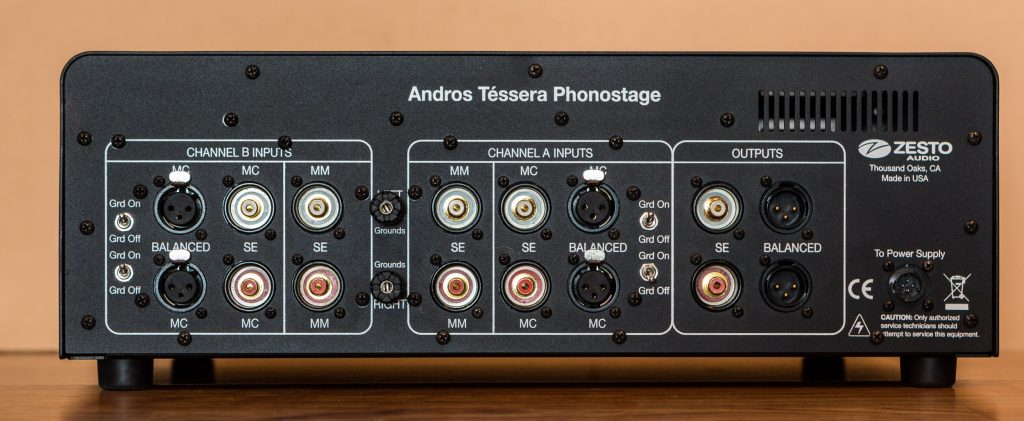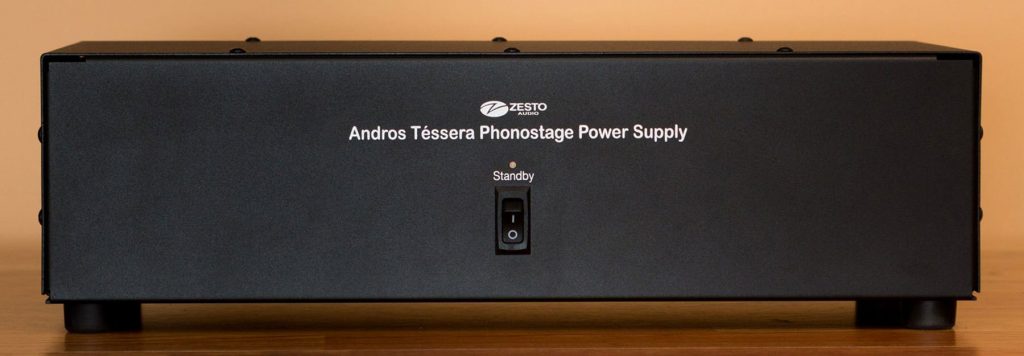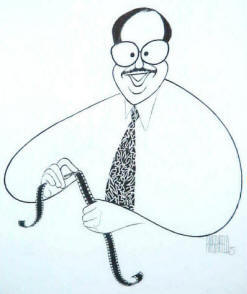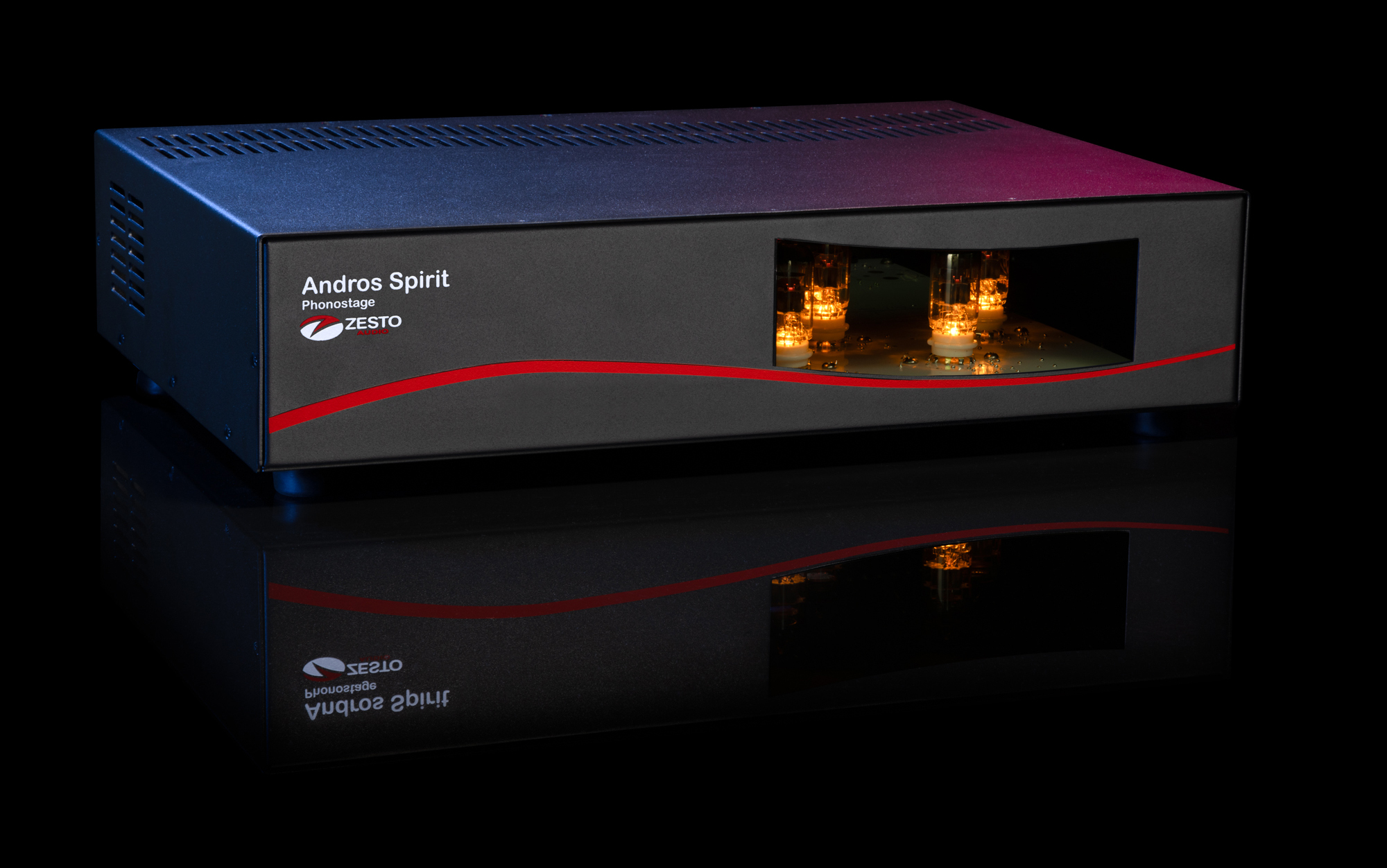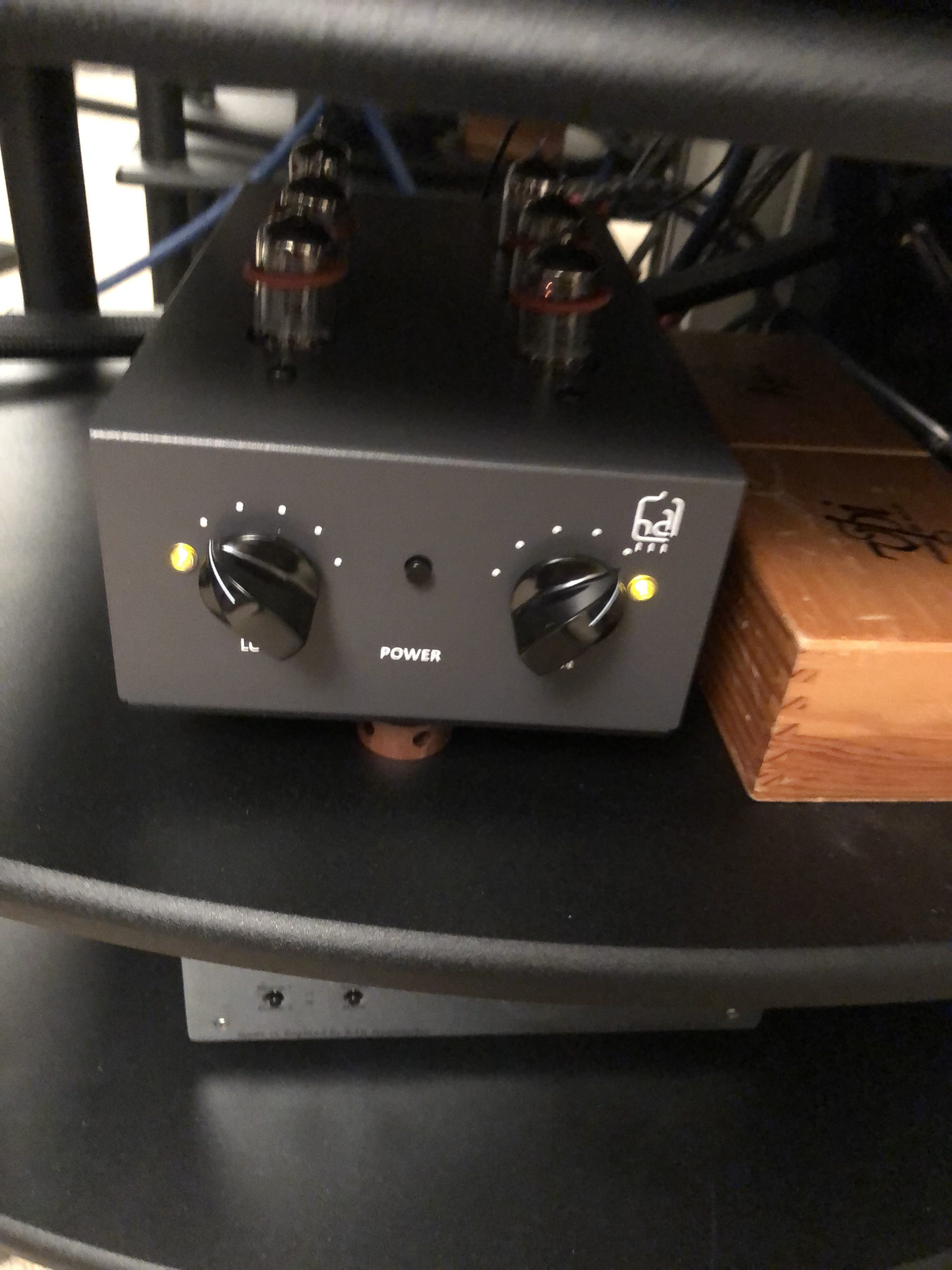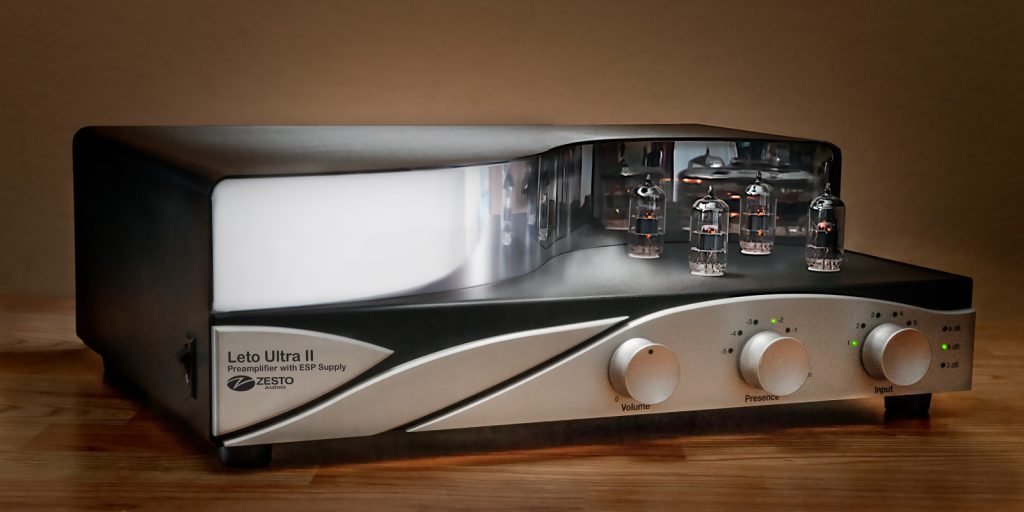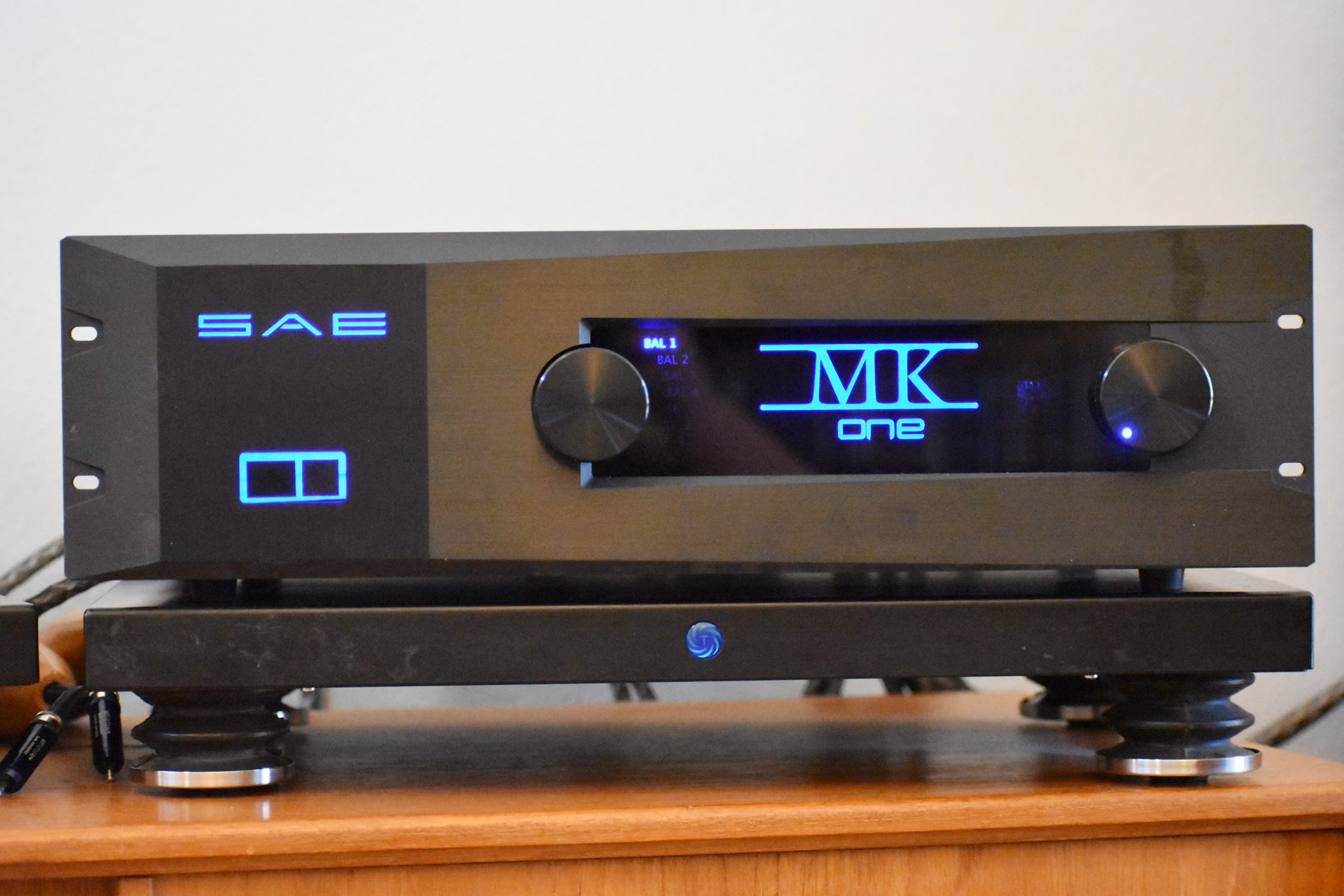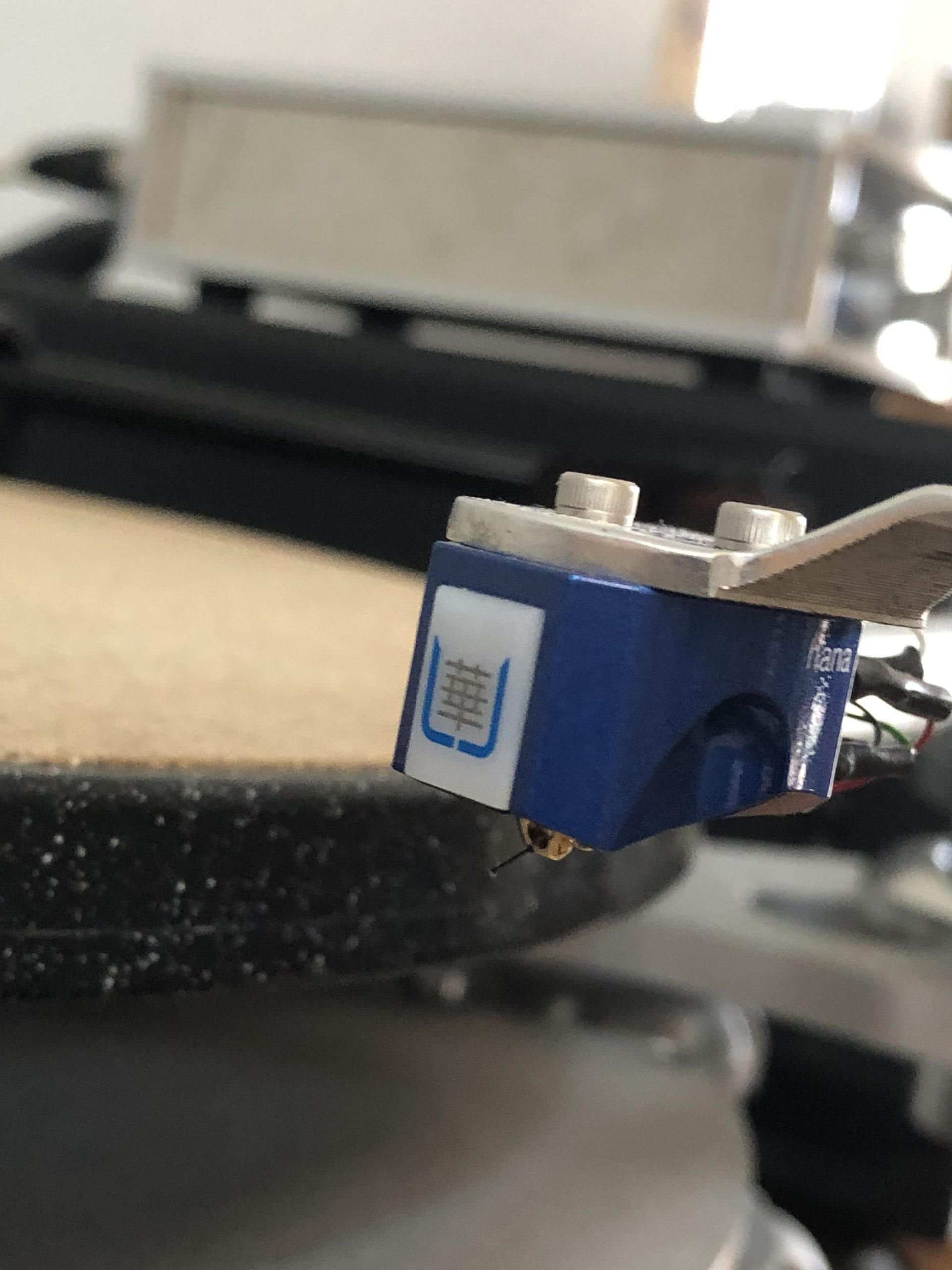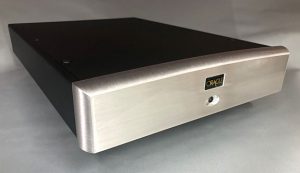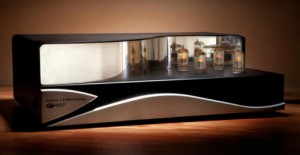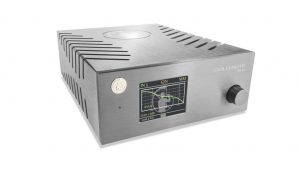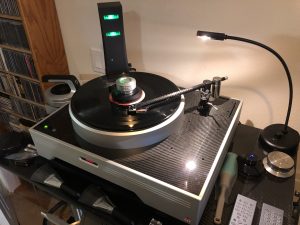Zesto's audio designer and chief engineer, George Counnas, reminds me of the late great William Z. Johnson of ARC fame. Johnson just had to think about what he wanted to build and then he built it. Easy! George Counnas just thought about the ultimate phonostage with flexibility never before seen in audiophile design history and just built it. His creative wife Carolyn, something William Z. did not have, designed the fluid modern look of the unit with even more elegance and motion than even they usually create. What a team! What a piece the Zesto Audio Andros Téssera phono stage is and this is its first review!
Left to right: Bob Levi, President of the LAOC Audio Society, with Carolyn Counnas, and George Counnas of Zesto Audio, at the LAOC Board Banquet, 2016 (photograph and image processing by David W. Robinson)
For a not inconsiderable $12,000, but $2000 less than ARC's latest model, you get double the flexibility and superior ergonomics. Without the ARC on hand I cannot speak to the sound, of course, though the latest reviews on the Reference Phono 3 are very positive.
Imagine... Tessera means "four" in Greek, and the mighty Zesto allows four tonearms to be linked simultaneously to the unit. All cartridges are maximized if two are MC and two are MM. Otherwise, add an outboard MC Step-up transformer to any MM input and switch up to four MC cartridges in four tonearms!
The easy-to-read front controls are elegantly and clearly displayed such that all are intuitive and switchable on the fly, with nary a pop. This is accomplished by having none of the seven controls on the front connect directly to the output stage. Instead, these controls hook to seventy relays that activate the changes silently and effectively with zero cross-talk or distortion.
The high quality back panel inputs and outputs give you XLR and RCA choices plus the ability to lift both grounds one at a time. As far as I know, no phono stages from any other major manufacturer offers separate left/right adjustable ground switches. This solved a hum problem I was having with one of my reference mono cartridges. Fantastic!
The power supply is a well-made full size black box with power switch and light in front which is placed up to three meters away from the control unit. It is firmly attached with a custom umbilical cord. Consequently, the six tube Zesto is as quiet as a mega-buck solid state behemoth. It always remains on and ready to go. You just switch the power on at the main unit which only requires ten minutes to warm to best performance.
The Tessera generates up to seven volts and is overload proof! It has such an enormous power supply that it is insensitive to RCA or XLR output cables fifty feet long. The Tessera does not invert phase.
Want flexibility until the cows come home? Here are the back panel goodies:
(Channel A and Channel B are identical)
- 2 Ground ON/OFF switch connects the ground to the MC input.
- XLR3 Transformer Balanced MC Input (Left and Right).
- Left channel = top row, Right channel = bottom row.
- Moving Coil RCA MC Input (Left and Right).
- Left channel = white RCA, Right channel = Red RCA.
- RCA Moving Magnet (MM) Input (Left and Right).
- Ground binding post/banana socket.
- RCA Output (Left and Right).
- XLR3 Transformer Balanced Output (Left and Right).
- Power Supply Umbilical.
Now for the front panel goodies:
(Channel A reading Left to Right)
- Power ON/OFF switch.
- MC/MM Selector Switch MC or 2 position MM Load
- LED Light indicates Channel A is On.
- Gain Switch 3 Position for MC & MM
- MC Load 12 Position MC Load
- Channel Selector, either A or B
(Channel B reading Left to Right)
- MC/MM Selector Switch MC or 2 position MM Load
- LED Light indicates Channel A is On.
- Gain Switch 3 Position for MC & MM
- MC Load 12 Position MC Load
- Channel Selector, either A or B
Now you get the idea! The Tessera features a 12 position MC Load control for your cartridges! (1000, 800, 700, 500, 400, 350, 300, 250, 200, 150, 100, 50 Ohms). My best reference has two and my other reference has three choices!
Inputs
- Two completely independent dual mono channels, A and B with LED indicator.
- Accommodates 4 tonearms, 2 per channel.
- Separate MM and MC inputs per channel.
- Each channel has independent controls and all selections are saved when you switch between channels.
- Selection switch for MC and 2 position MM 47K and MM 68K.
- MM impedance switch 47K or 68K Ohms · MM capacitance 220pf.
- MC transformer Balanced gold plated XLR input.
- MM and MC Single Ended RCA input, gold plated with isolated ground.
- MC ground on/off switch.
- MC load impedance adjustable 1000, 800, 700, 500, 400, 350, 300, 250, 200, 150, 100, 50 Ohms.
- Superior quality MC Internal step up transformers.
- 3 position MC gain switch for High, Medium & Low output cartridges.
- Two ground binding posts.
Detailed Specifications
- 3 position Gain MC input 60dB, 65dB and 70dB.
- 3 position Gain MM input 40dB, 45dB and 50dB.
- Noise – 90dBu below max output level.
- Frequency response complies with the original RIAA curve within +or- 0.5dB.
- RIAA curve is achieved using a passive filter.
- 1% metal film resistors throughout.
- Polypropylene capacitors throughout the audio path.
- All analog tube circuitry with no solid state devices in the signal path.
Just note the 50dB MM gain and the 70dB MC Gain possibilities with over 90dB of signal to noise ratio on board! The Tessera's noise floor is as good as gone while the dynamics knock your socks off! Plus, it is built right here in sunny California! It took George three years to design this work of audio art, and I see and hear why.
Reference Review Setup
- E.A.R. Disc Master Turntable with two Helius Omega Tonearms
- Grado Statement Version2 MM Stereo Phono Cartridge
- Grado Reference Version2 MM Mono Phono Cartridge
- Kubala-Sosna Elation Phono Cable RCA to Zesto for Stereo
- Jorma Origo Phono Cable RCA to Zesto for Mono
- Kubala-Sosna Elation Interconnect XLR to E.A.R. 912 Preamp from Zesto
- Kubala-Sosna Emotion and Elation Power Cords
- E.A.R. 890 Power Amps bridged to mono
- Marten Bird Loudspeakers plus REL Stadium 3 sub-woofer
The Final Tweaks
After tweaking the two cartridges via the ground switches to get maximum quiet and picking the loads, I listened to both cartridges into the 500 ohm MC inputs. They are rated at one mV output, a bit low for MM direct use (though it does work surprisingly well with the Tessera.) I used the supplied JJ premium small signal tubes with gold pins in all six positions: 2-12AU7s and 4-12AX7s. I attached the Kubala-Sosna Emotion Power Cord used with my reference. By the way, there is a superb synergy between the Grado Statement Version2 Cartridge and the Kubala-Sosna Elation Interconnect...both USA made. This combo is a world beater.
The Music
Alexander Nevsky, Prokofiev, Reiner, CSO, RCA LSC-2395, QRP Re-issue. My first reactions to this glorious re-issue from Mohr and Layton was power and glory. The Tessera has no lumps or bumps from top to bottom. It is smooth and even throughout all frequency ranges with unrestrained dynamic swings and an enormous soundstage. Depth was excellent, but the entire performance was a bit more intimate and forward than I remembered it with my reference. The overall sound was neutral as a bullet and clear as glass. Choral passages were exceptionally open and detailed. You could count the violins within the nicely weighty orchestral sound. Lots of jump and speed to the timpani thwacks. This is the best QRP reissue of a shaded dog I have heard to date! No quibbles here. I enjoyed this first listen with the Tessera like I enjoyed a first-growth Bordeaux. Marvelous.
I had a ton of fun trying the 400, 700, and 800 ohm settings and learning the differences. I still preferred 500 ohms with the Grados, but could imagine noting different settings for different albums! Easy to set on the fly even with your music at concert hall volume.
Just the Two of Us, Aimee and Figueiredo, Venus LP, VHJD97. Female vocal and guitar LPs are rare, and this one is superb and realistic, a true reference LP. Aimee was a bit more forward and snappy than my reference. The guitar was highly detailed and floating dead center in the soundstage. Background was jet black and retrieval of air was very good around the instruments. I heard the neutral open sound I had heard before with lovely harmonics and silky smoothness. There was plenty of dynamic swing to the guitar. The vocal was delicate at times, powerful at times, and always enticing throughout.
Tchaikovsky, Piano Concerto No.1, Janis, Menges, LSO, Mercury, Stereo LP SR90266. I just acquired this excellent original LP and it is lovely. Piano sound is stage center surrounded by the London Symphony. It is a Living Presence performance and is most enjoyable. Janis is in top form and the overall sound is full bodied and center hall. This is unusual for a Mercury LP. Mercurys are typically front row perspective. The Tessera does a great job communicating the age and flavor of this golden oldie...recorded in the summer 1960 in England.
Rimsky-Korsakov, Scheherazade, Dorati, Minneapolis Symphony Orch., Stereo Mercury SR90195. A perfect original Mercury, not a reissue, and it was lovely and slightly sweet. Producing upfront sound with a great sweet silky solo violin, I listened to the entire LP. It had more slam than I remember and had a broader soundstage. I will be mining my originals with the Tessera as well as new releases. I heard very authentic Mercury sound here. The Tessera is very neutral, letting me clearly hear the Mercury 1958 recording style.
Coltrane's Sound, SD1419, ORG Music, Grundman mastering, Atlantic master, Stereo 45 RPM, 2 LP set. This LP is killer live and fun with in-the-room performances and superb dynamics. Truly a top reference set for the audiophile jazz lover. Coltrane plays tenor or soprano sax for a real treat. Great sound and a great listen as Bernie Grundman cuts a masterful session. Expensive at $50, but who cares when they sound like this one. The neutral smooth sound of the Tessera lets you hear it all.
Jazz sur Seine, Jackson-Wilen-Heath-Clarke, Phillips Reissue, 77127, Mono. A killer jazz reissue that is done right. Milt Jackson plays piano like he is possessed and the Grado Reference Mono, at $1500, reproduced this LP with dense colors and real swing. I was very pleased with the Tessera with these mono performances. The focus of the instruments and depth of the image was spot on every time. Loved the quiet surface of this LP with just a touch of tape hiss. The Tessera added a touch of snap and stayed absolutely composed throughout. Excellent!
The Modern Jazz Quartet, Germany 1956-58. 101730, Jazz-Haus. Jackson, Lewis, Heath, Kay. Mono. What a great quartet and a well-done reissue! The Tessera really did swing with this mono LP and put you front and center with the performance. With wondrous definition, the Zesto did not let you down. Lots of air and snap on this LP. More air yet at 700 ohms, but a bit less textural information than the usual 500 ohms. It was great either way. Recorded in Germany, the mics and tubed gear must have been first rate as this is a perfect mono reference recording. Well done Tessera!
Tube Rolling (Sorry George!)
Hard to find any criticism of the Tessera even at its strong price point as it is delivered. However, I did, surprisingly, boost its performance by tube rolling. You never know until you try. The Tessera makes it easy with the six tubes right up top and clearly labeled.
Before changing tubes, be sure to turn off the control unit and put the correct value tubes in the appropriately marked spots. If you do not, you may screw something up and void the warranty!
I first replaced the 12AU7 tubes with two Mullard NOS 12AU7 tubes sourced from Kevin Deal, Upscale Audio, in Upland, CA. He is my go-to source for top-tested NOS and reissue tubes. I left the JJs in the other 4 positions.
I immediately heard an increase in textural information, particularly in the mids, and more air and depth retrieval with the Mullards. I re-listened to many LPs and was definitely pleased with this change with every choice. The Mullard 12AU7 is moderately pricey, but readily available. Upscale Audio is well stocked. I recommend you make this tube change for sure!
You might try NOS RCA and GE tubes as well. I think the drier Telefunken sound will be less satisfactory, but this is only an educated guess. If you have them, why not try them? I fully recommend the Mullards, however. My considered opinion is roll the 12AU7s with NOS Mullards for sure...this is the most cost-effective change you can make.
I then replaced the four JJ 12AX7 tubes with NOS Mullards. These are getting rare and are around $150 each or more. I sincerely hesitate to report, but the improvement in textural nuance, overall definition, and warmth with the Mullards was not subtle in my system. The problem is that all current tube manufacturers just do not put as much of the high-quality construction into the small signal tubes made today as they do into larger, more expensive power tubes. NOS tubes of the 50s, 60s, and 70s just perform better in most ways, you, as an audiophile, care about. With these six tubes rolled with superb NOS Mullards, (not reissues!), you will glimpse the ultimate in perfection of LP sound with the Tessera. Your only limit will be your cartridge choice in this world of audio ultimates.
Zesto cannot supply NOS tubes with their units as there is no reliable source for these in quantity or consistency. Do not fault them or ARC or VTL or any high end manufacturer. The JJ gold pin tubes are as good as they get in 2017 current production anywhere in the world. They are double checked by Zesto and thrown out if not sonically and electrically perfect. The Tessera is designed around these tubes to maximize their attributes. JJs are crafted in Slovakia, not Putin-ville, and are readily available.
If you do not tube roll, no problem. The Tessera is satisfying and superb the way it is delivered. Tube rolling is for audiophile perfectionists (like me.)
Summary
The Zesto Audio Andros Téssera phono stage is an amazing assault on the state of the art and the state of phonostage flexibility for the audiophile, and is done at a fair price. I know of nothing more adjustable, more flexible, and more musically consistent overall than the Tessera. With hookup from four tonearms simultaneously, an amazing noise floor, neutral-to-the-max musicality, great looks, and superb ergonomics, this is truly an outstanding accomplishment from this consistently winning 21st century company! You can pay more, of course, but one wonders what more is there to get? A toaster?
If you can afford the Zesto Audio Andros Téssera phono stage, buy it. It comes highly recommended!
Zesto Audio Andros Téssera phono stage
Retail: USD $12,000
Zesto Audio
US National Sales Manager
PJ Zornosa
610-853-9171
International Sales and Marketing
Carolyn
805-807-1841
[All photographs courtesy of Zesto Audio, unless otherwise indicated.]




